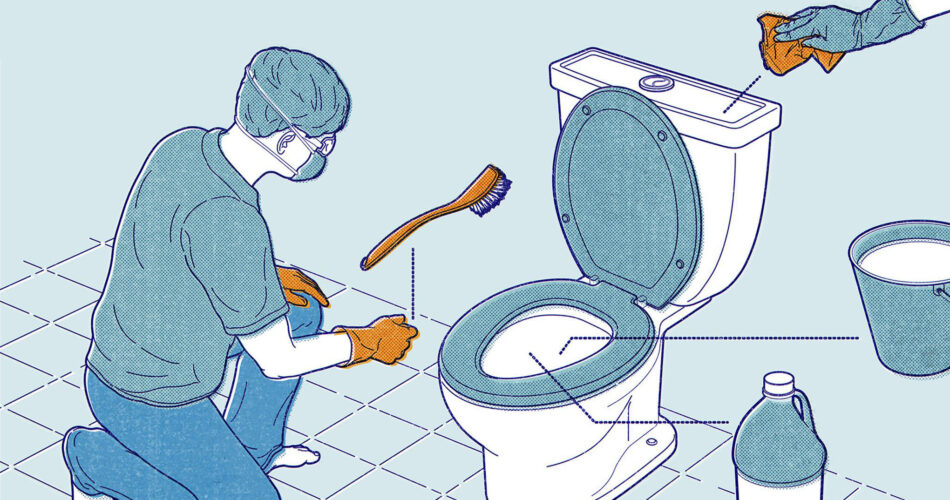Because sometimes it looks clean it’s not
Even when your toilet looks sparkling it doesn’t mean it’s perfectly clean.
As explained by Washington Post, at the Hudson College of Public Health at the University of Oklahoma, aerosol scientist Changjie Cai is in charge of a lab that investigates what there might be in the toilet bowl and what each flush might release into the atmosphere.
One lesson from his research is that occasionally we overlook cleaning the rim’s bottom of the toilet. It could be a serious problem, he warns. Because of the ideal environment, salmonella can survive there for a long time, months even.
It’s important to choose the correct toilet brush. Choose one with stiff, angled bristles so you can better access the trap’s interior and the underside of the rim (the hole in the bottom of the bowl). Getting under the rim can also be accomplished using an old toothbrush. After each use, it’s better to wash your toilet brush by placing it in its holder and filling it with hot, soapy water, rinsing it, and then repeating the process with cold water and a little bleach. It’s time to replace your brush if you use that procedure but your brush still doesn’t look clean.
Rubber dish gloves (reserved for bathroom usage exclusively) are a wonderful option because they reach almost to your elbow. Additionally, some experts advise donning a mask, especially if your ventilation is poor and you’re using items like bleach that need adequate airflow to be safe.
Simply applying a “disinfectant” on your toilet is all that the American Cleaning Institute recommends, but there are so many options available that choosing one might be challenging. One very important piece of advice: if a product’s label claims that it “kills 99.9% of viruses and bacteria”, it indicates the Environmental Protection Agency has confirmed it will work as promised.
The EPA’s “Safer Choice” label, which a product only acquires when the agency has decided that its contents meet certain requirements for human and environmental health while being effective, should be observed if harsh chemicals are a concern.
For a less complicated method, regular home bleach is still likely the most effective germ killer available. According to the EPA, use ⅓ cup liquid chlorine bleach per gallon of water. (If you use bleach, take special care to ventilate the restroom properly.)
Although many people use white vinegar to clean, it has a limited capacity to disinfect, according to NSF International, a company that tests products and creates public health guidelines for them. However, if you’re dealing with difficult stains, it’s worthwhile to include the pantry basic in your toilet cleaning toolkit. To safely and effectively remove dirt, try cleaning them using a paste made of three parts baking soda to one part white vinegar.
However, tablets for your tank containing bleach that promise constant cleaning aren’t a good solution because they may harm the rubber gaskets and seals on a toilet. Additionally, they are harmful to pets who drink toilet water.
Turn on the bathroom fan, open a window, or if possible, do both before you begin cleaning. Proper ventilation is crucial because of the fumes from your cleaning products and anything you leave in the air when scrubbing.
According to the Centers for Disease Control and Prevention, a toilet’s surfaces must be clear of any debris that could prevent your disinfectant from working correctly. Therefore, it’s vital to give exterior portions like the seat an initial wipe down and the bowl a preliminary brushing if you can see filth like hair, mold, and you can imagine what else.
It is not necessary to be a plumber to lower the water level. In certain toilets, you can simply flush by cutting off the water flow to the tank. If that doesn’t work, empty the bowl by plunging or by pouring in around one-and-a-half gallons of water; both actions will simulate a flush and stop the bowl from refilling.
Cleaning the bowl with less water is slightly better because you’re less likely to splash yourself. Reducing the water allows cleaning products to perform better since they are not as diluted and spend more time in direct touch with the toilet. It also reduces reflections, improving your perspective of what’s happening in the bowl.
Now you can really get down to business. Add your bowl cleaner and grab your angled brush. Be meticulous about scrubbing the underside of the rim, as well as the trap. Cai says both are often-neglected, hard-to-see areas that tend to become hot zones for biofilms, essentially, slimy colonies of microorganisms that attach to surfaces.
It’s a common error to immediately flush the cleaning agent from the bowl, which reduces its efficiency. If you want to disinfect, you must give the disinfectant enough time to come into touch with the surface. If you’re unsure, wait at least one minute and then proceed as suggested on the label.
Cleaning and sanitizing the toilet’s exterior is the last procedure. Spray and clean the top and underneath of the seat, the bowl base, the top and underside of the lid, the tank, the handle, and the hinges that attach the lid to the bowl with your EPA-verified disinfectant.
You can flush it once you’re through if you use a large wad of toilet paper for the task. If you use paper towels, throw them in the garbage right away to prevent cross-contamination. And keep in mind that every flush, not to mention every careless user that uses the restroom, sends all kinds of germs outside the confines of your toilet, so be sure to frequently clean the remainder of your bathroom as well.
